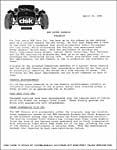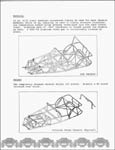 1. introduction
2. suspension
lessons
3. stressing
4. chassis
101
5. Autodynamics
6. jet
set
7. sun
set
8. Raceware
9. enter
the Seven
10. skin
deep
11. the
DSK concept
12. the
list list
13. DSK
hits the road
14. postscript
1. introduction
2. suspension
lessons
3. stressing
4. chassis
101
5. Autodynamics
6. jet
set
7. sun
set
8. Raceware
9. enter
the Seven
10. skin
deep
11. the
DSK concept
12. the
list list
13. DSK
hits the road
14. postscript

presented by
SimpleSevens.org
|
11. The DSK Concept
It was not long after that I
realized what was going on. I was redesigning the car one component
at a time in my head. The principles that I had learned in the
crucible of professional racing were so ingrained that the now
decades-old Super Seven technology simply looked wrong. There
was no way that I could build myself a car with all those "mistakes"
in the design. So I began discussing with Paul, Norm and the
others in the shop a completely new Super Seven kit car of our
own. Our design would retain all the old mounting points, but
between the bolts we would create new stronger parts that worked
according modern formula car practices. We would offer a fully
triangulated chassis of our own with up-to-date suspensions and
other systems that a Seven owner could retrofit to an original
Lotus as upgrades or "when things broke." It would
give us all a new market, perhaps even help mitigate the winter
business doldrums.
 |
Bulletin detailing the
complete DSK Chassis, indication of torque loads to rear axle
and comparison to original frame.
(A selection of additional
bulletins will soon be available in another area of this web
site)
|
 |
 |
 |
As we began the project in the
shop, we also contacted Caterham Cars. RaceWare became a dealer
for their kits and spares and we found sources for many other
Seven replacement and modification parts. We took on the Caterham
importer deal as natural extension of buying and reselling Lotus
Seven spares they supplied us. We had some tensions with Caterham,
but generally enjoyed selling their Seven (and working in the
shop with all new parts for a change).
We never did consider ourselves
in competition with Caterham Cars, but they did. That was one
of the tensions. They knew that we were developing our own model
and always seemed a bit paranoid about that. We saw them
as two different niches in the market. Theirs for the "classic"
and ours for the "street-racers." In hindsight,
that may have been naive.
We also began to fabricate some improved bits, First improved
rack blocks, then triangulated front A-frames. I still handled
morning business for RaceWare and ran my consulting practice
(that we called an advertising agency because we did not know
what a consulting company was) in the afternoon.
 |
One of the first 'Technical
Bulletins' offering DSK upgraded 'A-arms'
(A selection of additional
bulletins will soon be available in another area of this web
site)
|
One day Clayton Seitz walked
into my office and asked me to help him evaluate a business enterprise.
He was a friend of Avrum Belzer, a young D-13 racer that I had
helped set up in the BMW repair shop business that shared the
shop floor. I completed the assignment for Clayton and we talked
several times at my office. He peered through the window to the
shop one day and asked me about the Seven project. I described
my ambitious plans to build a modernized Seven with the character
of the classic and he loved the idea. He opined that he might
like to invest in such a venture. I replied that it was not a
venture, but an adventure and that investment was
probably not prudent. So he asked if he could help finance the
project by buying the second car we built. We agreed on a price
of $15,000 and shook hands.
As the project was gaining momentum,
Norman Marx got married. His beautiful fiery red headed wife
did not like me at all. We had an uncomfortable parting of ways
and I have always missed my dear friend Norm. I wonder what ever
happened to him and Katherine. Not too long after that, I moved
across town to the stone shop on Pond Street and Clayton bought
a substantial minority interest in DSK Cars in exchange for non-paying
job. He wanted to learn about cars and business and thought this
would be a fun place for him to grow. I liked him and his enthusiasm.
His willingness to back the growth of the dream with hard cash
made him even more likable. We had a lot of fun.
Tom Robertson and the 1977 SCCA National Champion
Lotus Seven
| Tom
Robertson was a successful Lotus Seven racer in the SCCA. At
some point, after winning the SCCA National Championship, he came to DSK looking for a "racers
deal" on parts. A sponsorship deal was arranged, but DSK
never really worked closely with Robertson although his name
and photos adorned DSK promotional folders and flyers. |
 |
|
from
Tom Robertson:
Hi John, Dave Kaplan simply copied and sold several of the suspension
components of my championship winning car in 1977. He also sold
artistic drawings etc. of my car. He never asked my permission
or paid me anything from the sales. He even asked me to sign
the artistic renderings of my car. However it did not really
bother me. Most of these components were designed by me and transformed
the car from a good handling car to a great handling car that
was capable of winning the runoffs, which it did. Some of those
same ideas were used in the Seven Pat [Prince Race Engineering]
built in 1995, which we raced very successfully for 4 years,
with many national wins and lap records. Included were June Sprints
wins in 1996 and 1997 and pole position at 1998 runoffs. Interesting
thing about the 1977 dream season (won every national race entered)
was we raced all season with a weak engine which was down about
20hp from the normal full race output. we had approx. 118hp compared
to 138hp available from the 1500 ford with dual 40dcoe's at the
time. If you have specific questions, I can probably answer them
for you. By the way, Pat and I designed and he built the lightest
racing Seven for SCCA F Production in 1993/4 which only weighed
825lbs.(948cc sprite powered) Regards, Tom |
David
Kaplans Response:
I think Tom Robertson is right. I don't think that he got much
out of our deal either. Nor did we. He bought some parts at a
discount and we used his name in advertising. We shared a little
technology, but not much. That was a typical deal with a racer.
After all, Tom was an amateur racer and we were a small shop.
Being the biggest Lotus Seven shop in the US is like being the
biggest hypnotist in Milwaukee - no big deal. Like most racers,
Tom probably thought he was bestowing greatness on us by allowing
us to use his name and image in advertising. He may well have
believed that it was worth more than he received. But we did
what we could to help him and Tom raced. He was not nearby and
was a secretive sort of recluse by nature back then. We were
a struggling small shop with only a few customers that raced
and a handful more that autocrossed. The SCCA had arcane rules
about what modifications were allowed, so things on Tom's car
just were useful. What he had worked out was not very important
knowledge to people who did not plan to race in SCCA production
sports car events. It just was not a significant part of the
market, nor very important to our business. Nor was DSK Cars
important to Tom. He was probably only in our shop two or three
times, and I was never in his. |
|
from Pat Prince:
John, You'll get a kick
out of chatting with Tom. He's full of crazy stories that are
all true! We didn't exactly prepare the world's lightest seven,
we built it from scratch. All .035 wall 4130 tubing, fully triangulated,
Fabricated uprights, wishbones, Penske shocks, Stack dash, etc.,
and right on the improbable SCCA min weight for FP. Tom, who
I had known casually for years, called winter of '94 to pitch
the FP Lotus project. He had such enthusiasm, and such an easy,
enjoyable manner, that I signed on. The car went together quickly...
When the season arrived, Tom asked if I would like to travel
and race with him. That was the start of many years of wild and
wacky adventures, great highs and lows, and a life- long best
friendship. The punch line is that, as sophisticated and light
as that car was, it had a higher top end riding in the trailer
than on a race track. We hadn't yet developed 7 aero, and couldn't
make the power to compensate. Later, we devoted a year and a
half to aero development in EP, and Tom put our little buzz-bomb
on the '98 Run- Offs pole.
I had nothing to do with Tom's
1977 Run- Offs winning 7. We had done 3 racing 7's together before
the FP project. The big front spoiler is definitely not part
of the aero program! Pat
|
next
page
|







